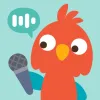Take a look inside 5 images
Sago Mini First Words
Pros: Great, quality video modeling and good use of device's camera for students to watch themselves.
Cons: The drills quickly start to feel tedious, and there's no depth beyond word pronunciation.
Bottom Line: These drills offer an easy, playful approach to working on proper pronunciation but not much beyond that.
Teachers can use Sago Mini First Words as a light tool to help students experiencing challenges with their speech development. However, teachers will definitely need to significantly supplement any serious effort to address speech challenges. There are no specific teacher tools such as progress tracking, data, or the ability to choose certain words to work on. For that reason, it would be difficult for teachers to use this for genuine, comprehensive speech support. But teachers could choose words to show to individual students or small groups. They could ask students to choose certain words to practice on their own. Or, teachers could simply let students explore and practice freely. Small doses are best, as each word exercise is essentially the same, and students may quickly lose interest.
Sago Mini First Words is a subscription-based app that uses video modeling and voice recognition to give young students practice with pronouncing and enunciating basic words. After watching a model say each word several times, students practice saying the word out loud while the app's software evaluates if they said it correctly. Kids can also use the device's camera to watch themselves and observe their mouth movements as they speak, and play with silly filters. As kids say the word correctly -- or close to correctly -- a sound bar at the bottom fills up to take them to the next activity. Teachers need to create an account and choose a subscription option before they're able to access the exercises. To play, kids browse the word category options available, such as animals, small numbers, vehicles, or family. Then they tap through the menus until they choose a word to work on. In between the speech exercises, kids play mini-games like putting puzzle pieces back together, or seeing the word used in a sentence. The main menu also includes mouth exercises in which kids watch videos of models making different movements with their mouth and tongue, such as fish lips or a cheek push, and then practice the movements themselves.
Though not made specifically for students with speech challenges, Sago Mini First Words fits best with those who need a little extra help with their speech development. The best features are the high-quality video modeling in which kid models do a wonderful job enunciating as they slowly and deliberately demonstrate saying each word. There's also lots of repetition, and Sago Mini First Words does a nice job allowing kids to watch themselves as they practice saying the word back. The voice recognition software works somewhat well to give students some feedback on how clearly they pronounced the target word, though it's also pretty easy for students to slide through without really saying the word correctly. The mouth exercises category is great for helping students move and control their mouth and tongue in various ways. That said, Sago Mini First Words is not a game. In fact, each word follows the exact same format, and kids may soon feel like they're doing practice drills. But it's also not a robust teaching or speech therapy tool. These drills have the potential to be useful for students who have some minor speech challenges, but they'll need lots of scaffolding from a teacher or speech therapist. And the need for something like this for students who are developing speech normally is debatable. Given the subscription price, teachers may find that this one is a pass.














